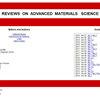Modification of PEEK for implants: Strategies to improve mechanical, antibacterial, and osteogenic properties
IF 3.6
4区 材料科学
Q2 MATERIALS SCIENCE, MULTIDISCIPLINARY
引用次数: 0
Abstract
Poly-ether-ether-ketone (PEEK), a biomaterial renowned for its mechanical prowess and biocompatibility, is increasingly preferred for medical implants. Its natural bone-like mechanical property, ease of manipulation, and ability to mitigate stress shielding render it a standout replacement for titanium in dental implantology. Adding carbon fiber and graphene to PEEK can further enhance the mechanical properties of PEEK. However, the biological passivity of PEEK hampers its efficacy in bone repair, driving spurring research into surface modifications to enhance its bioactivity. Incorporating metal, inorganic, and organic antimicrobial agents is anticipated to bolster PEEK’s resistance to bacteria, thereby reducing the risk of acute postoperative infections and peri-implantitis. Apart from its antimicrobial activity, researchers have also investigated methods to enhance the osteogenic properties of PEEK. These approaches include surface modification and blending modification. Surface modification includes physical modification, chemical modification, and biologically active substance modification. These methods can further enhance the implant integration and durability, potentially improving patient outcomes. This overview examines PEEK’s processing techniques and highlights recent research achievements in improving its biomechanical, antibacterial, and osteogenic properties. Considering these strides, we argue that modified PEEK holds significant promise as a material for dental implants, charting an encouraging course for its clinical future.用于植入物的聚醚醚酮改性:改善机械、抗菌和成骨特性的策略
聚醚醚酮(PEEK)是一种以机械性能和生物相容性著称的生物材料,越来越多地用于医疗植入物。聚醚醚酮(PEEK)具有天然仿骨的机械特性,易于操作,并能减轻应力屏蔽,因此在牙科植入物领域是钛的理想替代品。在 PEEK 中添加碳纤维和石墨烯可进一步提高 PEEK 的机械性能。然而,PEEK 的生物被动性阻碍了其在骨修复方面的功效,这也推动了对其进行表面改性以增强其生物活性的研究。加入金属、无机和有机抗菌剂有望增强 PEEK 对细菌的抵抗力,从而降低术后急性感染和种植体周围炎的风险。除了抗菌活性,研究人员还研究了增强 PEEK 成骨特性的方法。这些方法包括表面改性和混合改性。表面改性包括物理改性、化学改性和生物活性物质改性。这些方法可以进一步提高植入物的整合性和耐用性,从而改善患者的治疗效果。本概述探讨了 PEEK 的加工技术,并重点介绍了最近在改善其生物力学、抗菌和成骨特性方面取得的研究成果。考虑到这些进步,我们认为改性聚醚醚酮作为牙科植入物的材料前景广阔,其临床前景令人鼓舞。
本文章由计算机程序翻译,如有差异,请以英文原文为准。
求助全文
约1分钟内获得全文
求助全文
来源期刊

Reviews on Advanced Materials Science
工程技术-材料科学:综合
CiteScore
5.10
自引率
11.10%
发文量
43
审稿时长
3.5 months
期刊介绍:
Reviews on Advanced Materials Science is a fully peer-reviewed, open access, electronic journal that publishes significant, original and relevant works in the area of theoretical and experimental studies of advanced materials. The journal provides the readers with free, instant, and permanent access to all content worldwide; and the authors with extensive promotion of published articles, long-time preservation, language-correction services, no space constraints and immediate publication.
Reviews on Advanced Materials Science is listed inter alia by Clarivate Analytics (formerly Thomson Reuters) - Current Contents/Physical, Chemical, and Earth Sciences (CC/PC&ES), JCR and SCIE. Our standard policy requires each paper to be reviewed by at least two Referees and the peer-review process is single-blind.
 求助内容:
求助内容: 应助结果提醒方式:
应助结果提醒方式:


